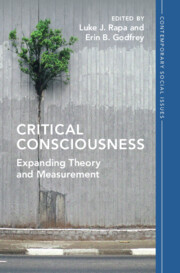Book contents
- Critical Consciousness
- Contemporary Social Issues
- Critical Consciousness
- Copyright page
- Dedication
- Contents
- Figures
- Tables
- Contributors
- Acknowledgments
- Introduction Critical Consciousness Theory and Measurement
- Part I Theory
- Part II Measurement
- 7 Critical Consciousness Measurement
- 8 Using Social Network Analysis to Identify Individual and Structural Precursors for Promoting Critical Consciousness in Childhood and Adolescence
- 9 Conceptualizing Adolescents’ Daily Critical Consciousness
- 10 Measurement and Analysis in Quantitative Critical Consciousness Research
- 11 The Development of the Contemporary Critical Consciousness Measure-Short
- Conclusion Expanding Critical Consciousness Theory and Measurement
- Index
- References
7 - Critical Consciousness Measurement
A Brief History, Current Status, and New Directions
from Part II - Measurement
Published online by Cambridge University Press: 20 April 2023
- Critical Consciousness
- Contemporary Social Issues
- Critical Consciousness
- Copyright page
- Dedication
- Contents
- Figures
- Tables
- Contributors
- Acknowledgments
- Introduction Critical Consciousness Theory and Measurement
- Part I Theory
- Part II Measurement
- 7 Critical Consciousness Measurement
- 8 Using Social Network Analysis to Identify Individual and Structural Precursors for Promoting Critical Consciousness in Childhood and Adolescence
- 9 Conceptualizing Adolescents’ Daily Critical Consciousness
- 10 Measurement and Analysis in Quantitative Critical Consciousness Research
- 11 The Development of the Contemporary Critical Consciousness Measure-Short
- Conclusion Expanding Critical Consciousness Theory and Measurement
- Index
- References
Summary
In this chapter, we review the quantitative measurement of critical consciousness that has emerged within developmental and applied research over the last few decades. We provide a brief history and offer an overview of the current status of critical consciousness measurement. We also introduce four “phases” of critical consciousness measurement, which we refer to as (1) proxy measurement; (2) scale development; (3) scale expansion and (re)specification; and (4) scale refinement and adaptation. Due to their central role in critical consciousness measurement, we pay particular attention to instruments appearing in phase two, the scale development phase. After summarizing each phase, we identify opportunities for advancement and innovation in critical consciousness measurement and point to important new directions for measurement work in this area of scholarship – many of which are addressed more extensively in subsequent chapters of this volume.
Keywords
- Type
- Chapter
- Information
- Critical ConsciousnessExpanding Theory and Measurement, pp. 173 - 201Publisher: Cambridge University PressPrint publication year: 2023



